Smaller Meals, and More Frequent, for Senior Cats
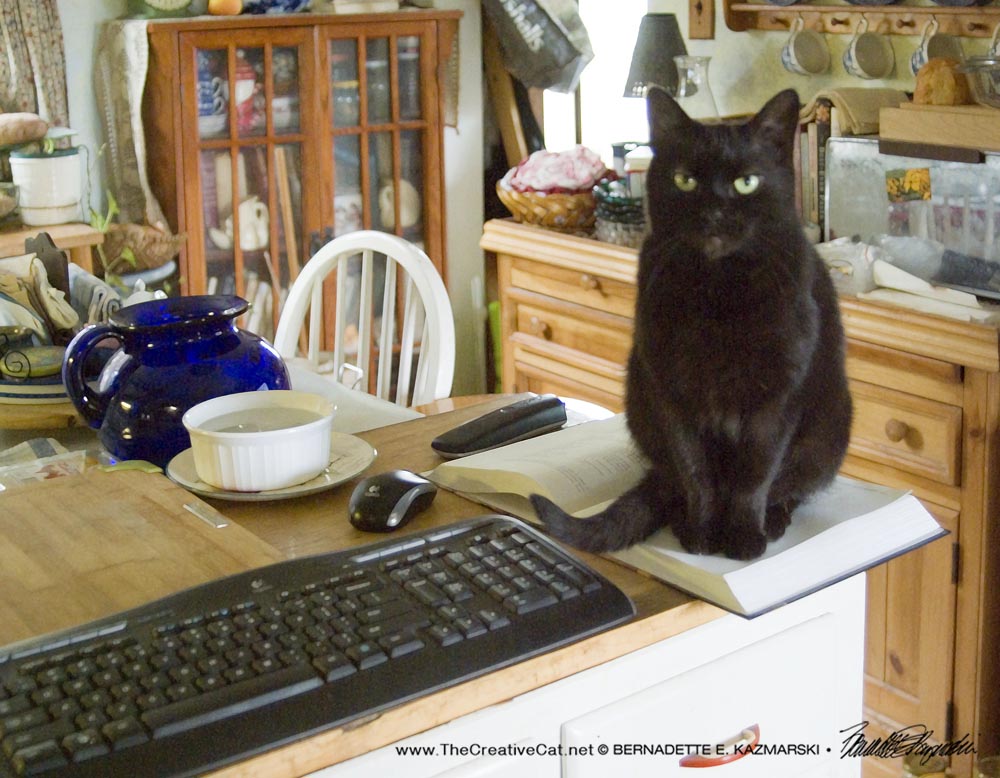
You may not realize it, but “little Mimi cat” is actually in the geriatric portion of the feline age chart. Yes, the “little black cat” who goes with everything in this household, follows me around a good bit of the day, greets guests and runs around outside in the yard has entered her upper teens. To my best remembrance of seeing her outdoors, she was four years old when she joined our household in 2007. If she was born in 2003, then this year she turns 17 years old. She’s working on surpassing her fur sisters Peaches and Cookie and Kelly who lived to be 19 and 20, and maybe try for the record of besting Stanley at 25.
Above, Mimi lets me know it’s time for her to eat. I took this photo in 2014, when Mimi was 11, and as if she knew she’d entered into that senior category she let me know it was time for senior feeding schedules to start. Mimi weighed 7.5 pounds at most when she was about five years old. Right now she weighs just about six pounds, so even a few ounces of weight count. She is small and her stomach is small, but for all the time up to that point she had eaten as much as her much larger children at each meal.
At age 11 she started to eat less but added one extra meal between morning and evening, then added a second evening meal, then more as the years have passed, as have all my other senior and geriatric cats. In the early 00s, when that first family of rescues began aging into the geriatric category, I was concerned they were eating less, then realized they were coming to the kitchen in between meals. I fed them a little extra each time, they thrived. Thanks for the lessons, Moses, Stanley, Nikka and all the others.
Mimi is one in a long line of cats who’ve reached this esteemed age, then headed onto even greater age, and all of them have taught me that not only what they eat but how they eat it is very important. Over the years I described what I saw to my veterinarian and she explained what happened as they aged. I modified how I fed them accordingly to help them easily digest food and feel comfortable between meals, full, and with no buildup of stomach acid, and keeping them hydrated along with it. This includes these guidelines:
• more frequent meals
• smaller meals
• easily digested proteins
• quality proteins
• fewer ingredients for overall digestibility
• canned food rather than dry food
Smaller meals, more often
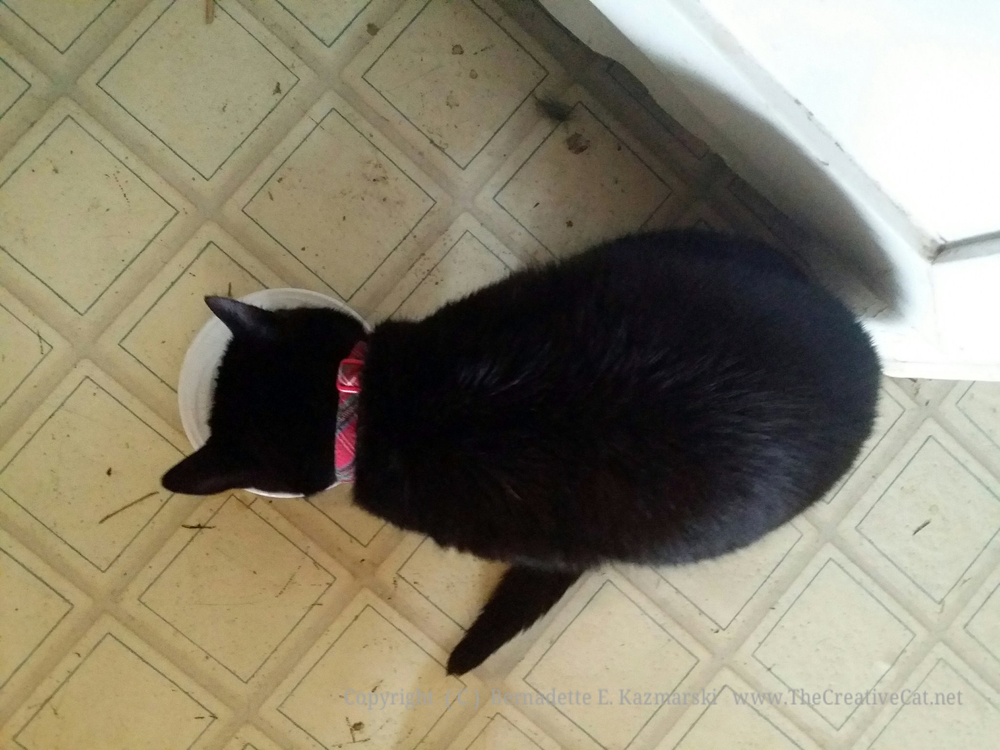
If you feed at specified times, consider feeding extra meals in between regular meals. Just like senior people, an older cat will eat less at each meal and her digestion can only handle a certain amount at each meal, but she needs just as much food through the course of a day. When my older cats began to indicate they needed to eat between meals I began purchasing a variety of smaller cans of cat food for the convenience of the food being fresher because I opened smaller cans more frequently. Wet food smells a little stronger when it’s fresher, and as cats age and may lose smell or taste sensitivity the stronger the food smell, the better.
Feeding at specified times instead of leaving food available all the time is a good idea all through your cat’s life. The food is always fresh, and sense of smell is what prompts a cat to eat; with aging this becomes critical. The smell of food starts the body’s digestive process rolling, but any animal’s body needs to rest from digestion between meals including humans’, and removing food lets the cat’s digestion work on its last meal, then rest before starting up again. With more frequent meals she doesn’t go as long between meals with the chance of building up stomach acid that may cause her to reflux from an empty stomach. Also, monitoring your cat’s dining habits is important as she ages, and a change in her consumption or even her attitude toward mealtime and her food can often be the first early indicators of a health problem.
Easily digested, quality protein
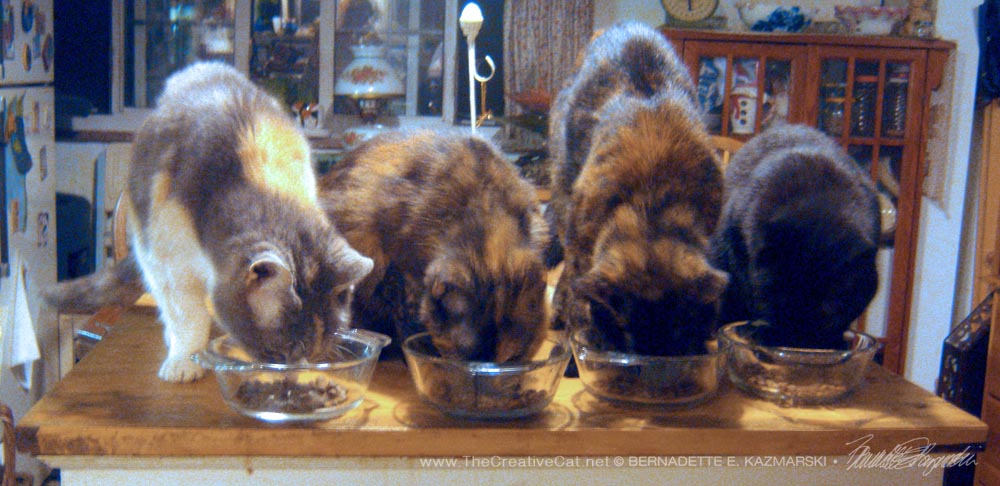
A good quality senior cat food should have adequate protein to maintain body weight and muscle mass, moderate to high fat levels, omega-3 fatty acids and high antioxidant levels, and low phosphorus. Feed a variety of foods to keep it interesting and to give your cat a greater balance of proteins and ingredients, even before the senior years. That’s the best way to help prevent a “finicky” cat from the very beginning, but it’s very important as they grow older that they haven’t learned to enjoy only one or two brands or flavors or styles of food because appetite is often an issue with older cats. If it’s wet food, stay with pate rather than including gravies or chunks because these have starches that can be difficult to chew and/or digest.
While many senior foods may advertise reduced protein content because it’s assumed to be more easily digestible for an older cat or a cat showing early symptoms of renal failure, the only content that should be reduced is calories if kitties are a little chunky or aren’t as active, just like a human diet or senior program. Cats are “obligate carnivores”, meaning that they must eat protein to maintain their body tissue. Often cats lose muscle mass as they age, and that happens even faster with a protein-restricted food, resulting in an underweight cat if protein is too restricted. If protein is changed at all it should only be made more easily digestible, but should still be animal protein, not vegetable protein—what’s difficult to digest is often grains added as protein.
Most of all, consider the ingredients of your cats’ food, and even consider a limited-ingredient diet with mostly quality protein, or a minimally-processed, home-cooked, or even raw food diet for optimum nutrition to give your senior the most accessible nutrition in each bite of food.
Fiber
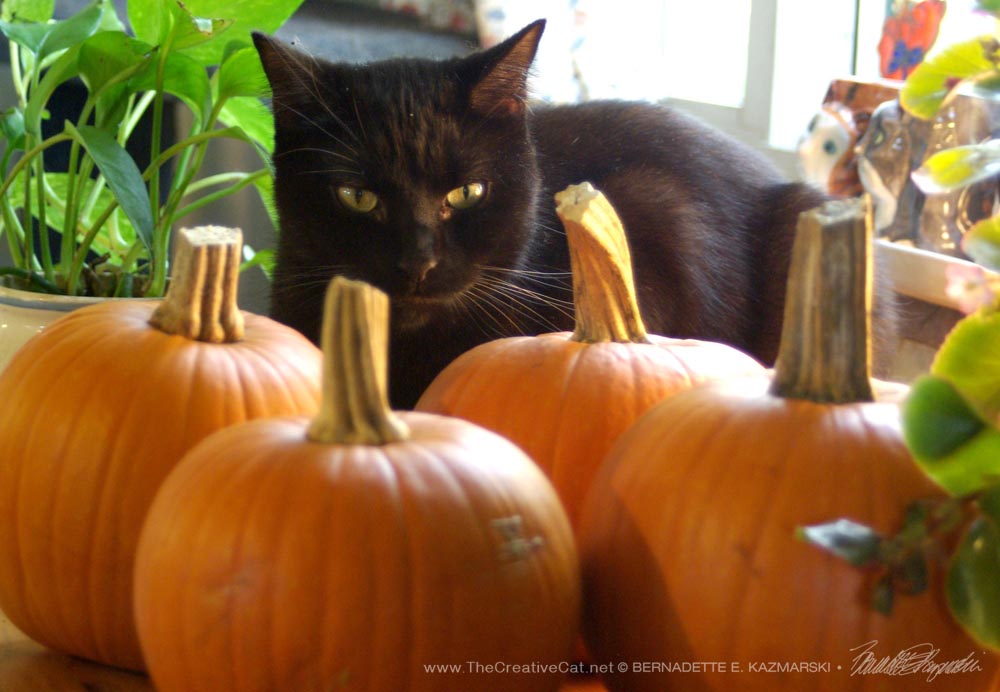
Constipation is often an issue with senior cats, and while it may only seem an annoyance it can be draining and even fatal for an elderly cat because of declining muscle mass and possible arthritis in their hips and legs. Defecating takes muscle strength and balance, and if stool is hard or difficult to move a cat will become constipated. A number of factors can cause stool issues such as diet, dehydration, swallowed fur, lack of exercise along with a list of medications and medical conditions. Adding or increasing fiber in food also helps keep stool from hardening as the cats’ digestion changes and constipation may become an issue, also aiding in hairball prevention. You can also add plain canned pumpkin to the canned food or just give pumpkin to your cat to help keep stool a little softer.
Wet food instead of dry

When Peaches was with us I was feeding dry food for economic reasons; Namir’s cardiac condition was fairly expensive. But when Peaches began eating less I knew she needed supplemental meals, and it would be best if they were wet food instead of dry. Peaches was pleased with this decision, and feeding her canned food between meals wasn’t too disruptive to the household.
If you currently feed only dry food or leave dry food available all the time, you should begin feeding an increased amount of wet food. It has a stronger smell to attract your cat, is easier to chew and swallow, and the increased moisture content is always a benefit—you can even add water to it to make sure your cat gets as much water as possible. If your cat’s kidneys aren’t processing water as efficiently as they should and she’s always a little dehydrated, eliminating a food that pulls extra water to be digested will help relieve the work they have to do.
I will cover hydration, just as important as food, in another article.
So how and what does Mimi eat?
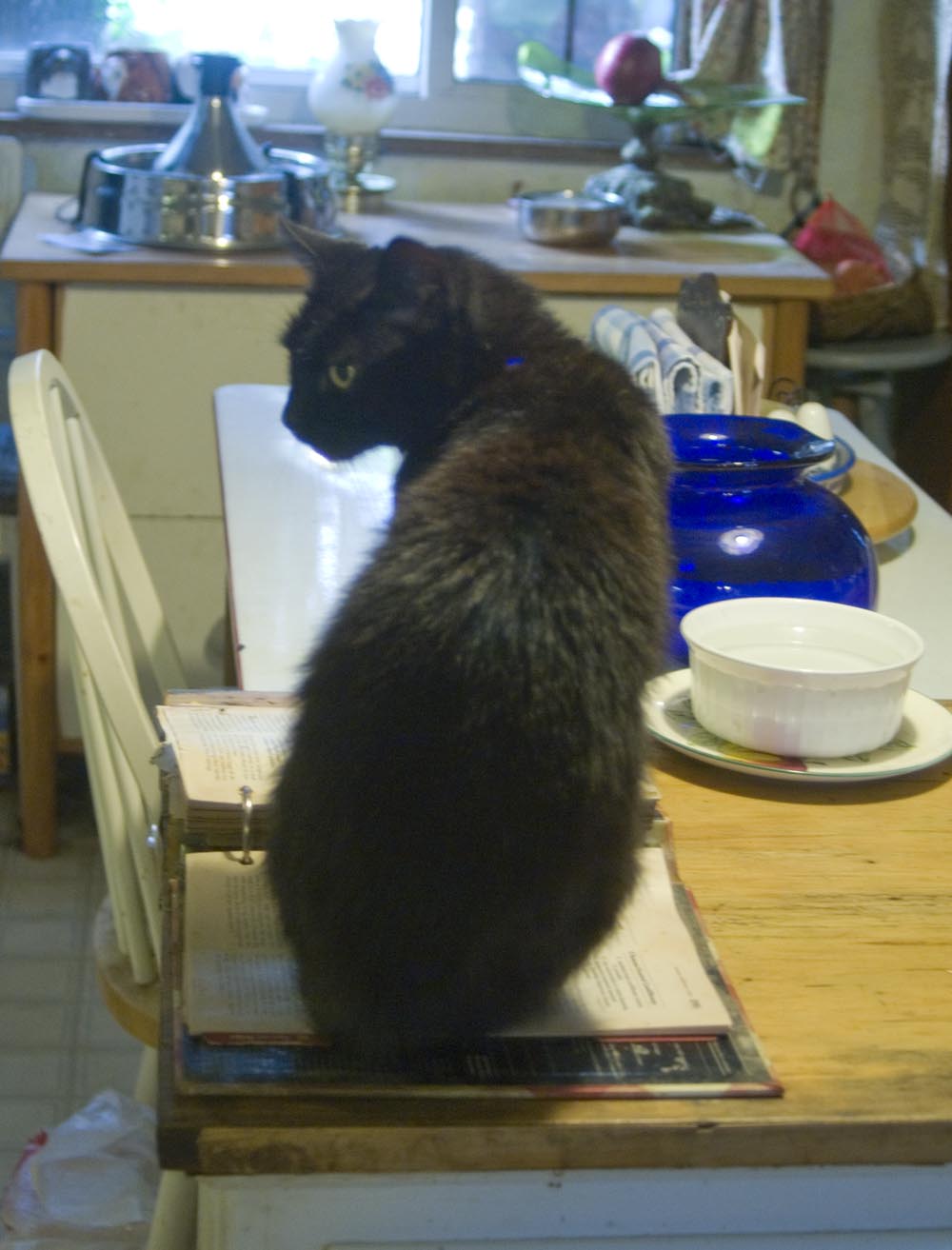
Now she eats just about every four hours, sometimes just a teaspoon, but usually more, with a little warm water added to make it more appetizing, including her shared meals in the morning and evening. In the end, she eats about six to eight ounces of food each day. I feed a spectrum of various brands, flavors and content of canned pate, commercial prepared fresh food, homemade cooked food, and homemade raw food from a local raw mix.
I track generally what the household eats each day and note any changes in interest or behavior, and especially watch Mimi. For the past couple of years she’ll start to become dehydrated and eat less, with less enthusiasm, every two to three months. This will develop into a pretty serious condition, with reflux and vomiting foam and fluid and a general lack of appetite, within days she’ll be dehydrated, her fur will get that greasy look and she’s lethargic. If I don’t catch it quickly she will need fluid therapy and sometimes appetite stimulants and even syringe feeding, and she’ll lose some weight. My veterinarian has always suspected she has some mild IBD and may have always had it, or a digestive condition could have developed while she was living primarily outdoors and giving birth to kittens from the stress on her little body. In 2015 she developed a condition that acted a lot like lymphoma and almost required hospitalization. For all those reasons I try to catch it before it becomes that serious by starting with treating suspected reflux and adding the alternative therapies from Dr. Michelle, and I always let my veterinarian know. So far we’ve been good.
Of course, her children are seniors now too, and this year will be 13 years old. Mewsette joined Mimi in eating less at regular mealtimes and having a meal or two between, though not consistently yet.
I have been considering adding an extra meal for everyone mid-day, and am definitely working out a system of food puzzle toys to add extra small meals in the afternoon and overnight. They are all active and hunt regularly as play, but with some absolute food obsessives the trick will be to make sure everyone gets some instead of Giuseppe finding them all!
 Read more about senior cat care
Read more about senior cat care
I have a two-part article on the topic of caring for your senior cat, including symptoms to look for and precautions to take with their health to help ensure the longest and healthiest life possible, and how to make their environment comfortable as their physical needs change. This was inspired by a long line of felines in my household who lived to be 15, 18, 20 and older and supported by my veterinarian and a number of books and reference sites.
I’m proud to say that part two of the series won a Muse Medallion in the Cat Writers’ Association’s 2007 Communications Contest and the Hartz Mountain Everyday Chewable Vitamin Award for the best article on senior cat care in the same contest. That’s when I joined the Cat Writers’ Association and it’s been one of the best associations I’ve made in my career for both writing and learning.
Click here to read Loving Care for Your Senior Cat
Read more articles about Health and Safety and Veterinary Medicine.
Gifts featuring cats you know! Visit Portraits of Animals
Fine Art • Photography • Gifts • Greeting Cards • Books • Commissioned Portraits & Artwork
Great Rescues Day Book:
Portraits, Rescue Stories, Holidays and Events, Essential Feline Information, All in One Book
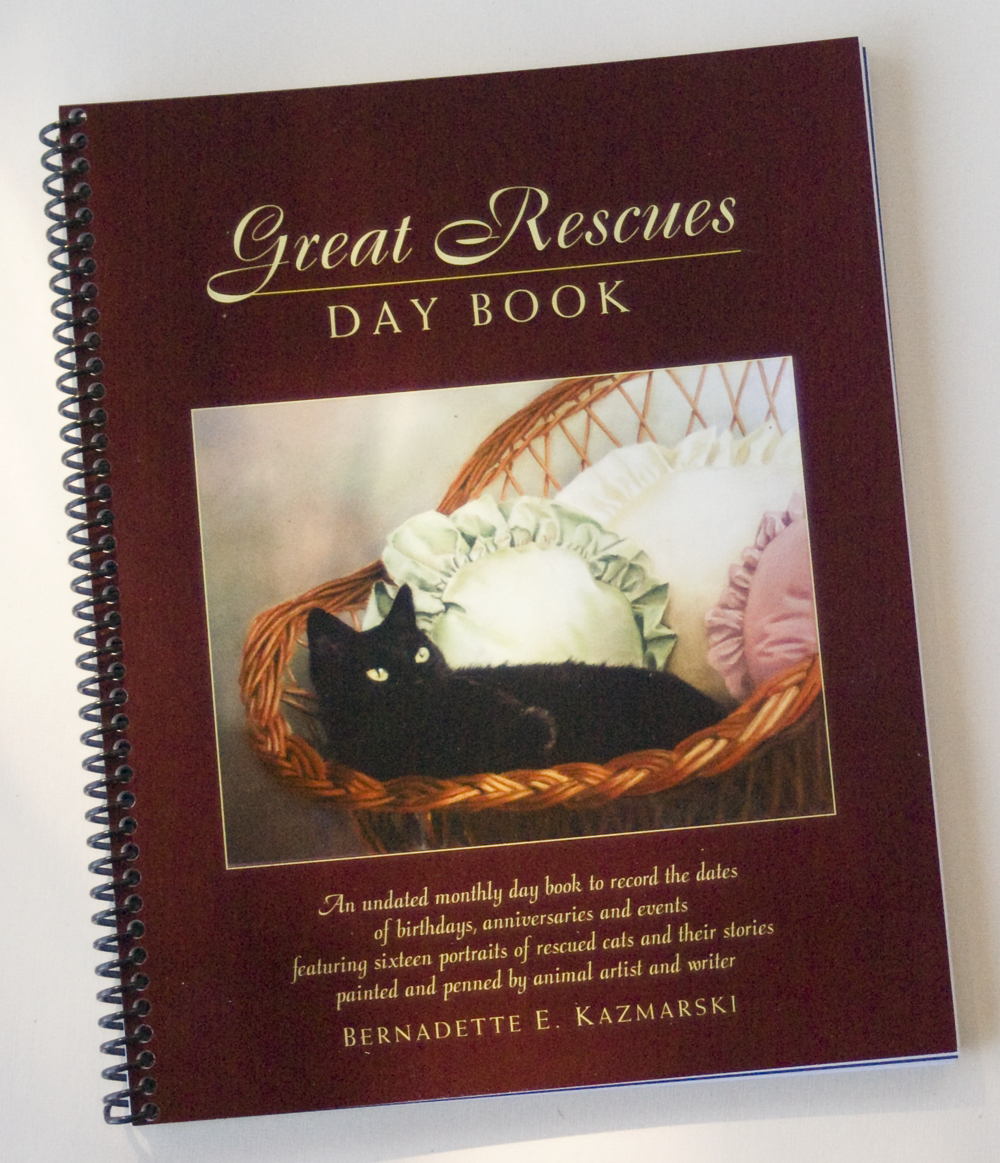
This information is part of what’s available in Great Rescues Day Book!
Each month features one of my commissioned portraits of a feline or felines and their rescue story along with a kitty quote on the left page, and on the right page the month name with enough lines for all possible dates, with standard holidays and animal-themed observances and events. Great Rescues also includes a mini cat-care book illustrated with my drawings including information on finding strays or orphaned kittens, adopting for the first time or caring for a geriatric cat, a list of household toxins and toxic plants, or helping stray and feral cats and beginning with TNR.
Each book includes also 10 sheets of my “22 Cats” decorative notepaper with a collage of all the portraits in black and white so you can make your own notes or write special notes to friends.
The portraits in this book, collected as a series, won both a Certificate of Excellence and a Muse Medallion in the 2011 Cat Writers’ Association Annual Communication Contest, as well as the 22 Cats Notepaper mentioned below.

Copyright
All images and text used on this site are copyrighted to Bernadette E. Kazmarski unless otherwise noted and may not be used without my written permission, although links to your site are more than welcome and are shared. Please ask if you are interested in using and image or story in a print or internet publication. If you are interested in purchasing a print of an image or a product including it, check my animal and nature website Portraits of Animals to see if I have it available already. If you don’t find it there, visit Ordering Custom Artwork for more information on a custom greeting card, print or other item.
Subscribe to my e-newsletter
Subscribe to The Creative Cat Preview E-newsletter.
© 2022 | www.TheCreativeCat.net | Published by Bernadette E. Kazmarski
Weekly schedule of features:
Sunday: Essays, Pet Loss, Poetry, The Artist’s Life
Monday: Adoptable Cats, TNR & Shelters
Tuesday: Rescue Stories
Wednesday: Commissioned Portrait or Featured Artwork
Thursday: New Merchandise
Friday: Book Review, Health and Welfare, Advocacy
Saturday: Your Backyard Wildlife Habitat, Living Green With Pets, Creating With Cats
And sometimes, I just throw my hands in the air and have fun!







